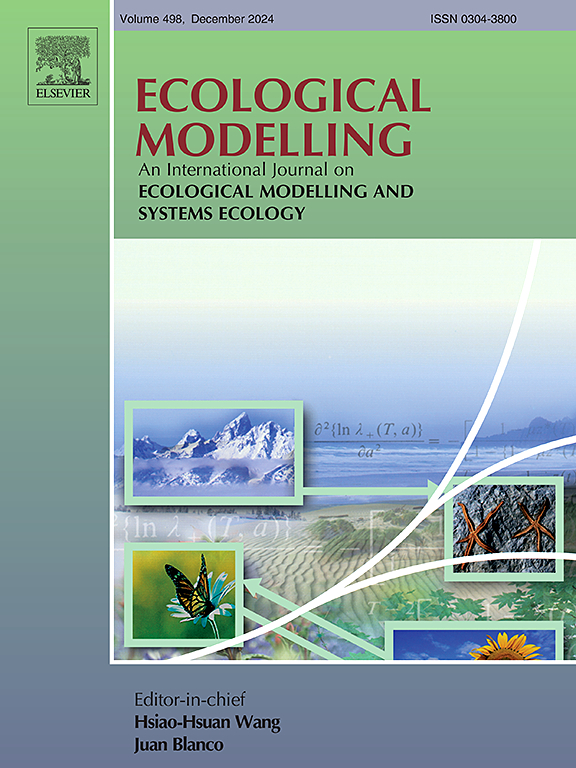在双宿主-双病原体系统中,共同感染个体内的优先效应如何扩大影响疾病风险
IF 2.6
3区 环境科学与生态学
Q2 ECOLOGY
引用次数: 0
摘要
单个宿主被局灶病原体感染的风险取决于群落中的其他宿主和病原体种类。利用两种环境传播病原体和两种宿主物种的模型,我们探讨了共同感染个体内的优先效应和种间宿主竞争如何共同影响局灶病原体的感染风险。为了做到这一点,我们使用传染性传播体密度作为感染风险的代理,并计算出局灶病原体的传染性传播体密度对替代病原体的传染性传播体密度的(局部)敏感性的明确公式。我们使用这些公式来确定形成感染传播体密度之间关系的生物过程,从而确定随着替代病原体丰度的增加,局灶病原体的感染风险如何变化。我们发现,这种关系的可能形状的范围是由两个物种的单感染和共感染个体的相对脱落和死亡率来预测的,但丰度和脱落率较高的宿主物种具有更大的影响。然后,我们使用来自水蚤及其寄生虫的参数集来模拟我们的模型,并展示了种间宿主竞争和宿主易感性如何影响关系的形状。我们发现,不对称的种间寄主竞争减少了这种关系的可能形状范围,因为它抑制了一个寄主物种的密度,而寄主的易感性可以增加可能的关系范围。我们的研究结果显示了宿主内病原体相互作用如何扩大到影响人群水平的感染风险措施。本文章由计算机程序翻译,如有差异,请以英文原文为准。
How priority effects within co-infected individuals scale up to affect disease risk in a two-host-two-pathogen system
An individual host’s risk of infection by a focal pathogen depends on the other host and pathogen species in the community. Using a model of two environmentally transmitted pathogens and two host species, we explore how priority effects within co-infected individuals and interspecific host competition jointly influence infection risk by a focal pathogen. To do this, we use infectious propagule density as a proxy for infection risk and compute explicit formulas for the (local) sensitivity of infectious propagule density of the focal pathogen to infectious propagule density of the alternative pathogen. We use the formulas to identify biological processes shaping the relationships between the infectious propagule densities, thus determining how infection risk by the focal pathogen changes as the abundance of the alternative pathogen increases. We find that the ranges of possible shapes of the relationships are predicted by the relative shedding and mortality rates of singly-infected and co-infected individuals of both species, but the host species with greater abundance and greater shedding rates has larger effects. We then simulate our model using parameter sets derived from Daphnia and their parasites and show how interspecific host competition and host susceptibility influence the shapes of the relationships. We find that asymmetric interspecific host competition reduces the range of possible shapes for the relationships because it suppresses the density of one host species whereas host susceptibility can increase the range of possible relationships. Our results show how within-host pathogen interactions can scale up to affect population-level measures of infection risk.
求助全文
通过发布文献求助,成功后即可免费获取论文全文。
去求助
来源期刊

Ecological Modelling
环境科学-生态学
CiteScore
5.60
自引率
6.50%
发文量
259
审稿时长
69 days
期刊介绍:
The journal is concerned with the use of mathematical models and systems analysis for the description of ecological processes and for the sustainable management of resources. Human activity and well-being are dependent on and integrated with the functioning of ecosystems and the services they provide. We aim to understand these basic ecosystem functions using mathematical and conceptual modelling, systems analysis, thermodynamics, computer simulations, and ecological theory. This leads to a preference for process-based models embedded in theory with explicit causative agents as opposed to strictly statistical or correlative descriptions. These modelling methods can be applied to a wide spectrum of issues ranging from basic ecology to human ecology to socio-ecological systems. The journal welcomes research articles, short communications, review articles, letters to the editor, book reviews, and other communications. The journal also supports the activities of the [International Society of Ecological Modelling (ISEM)](http://www.isemna.org/).
 求助内容:
求助内容: 应助结果提醒方式:
应助结果提醒方式:


